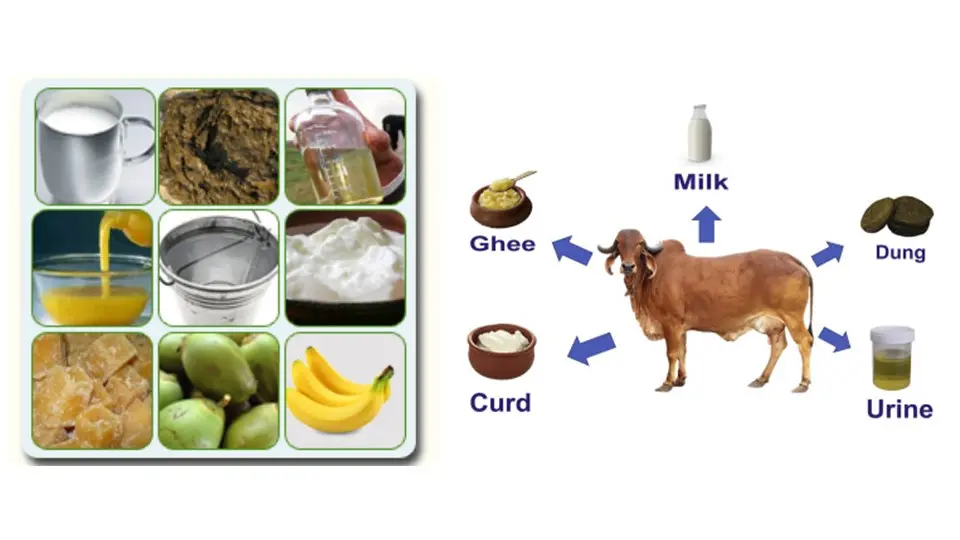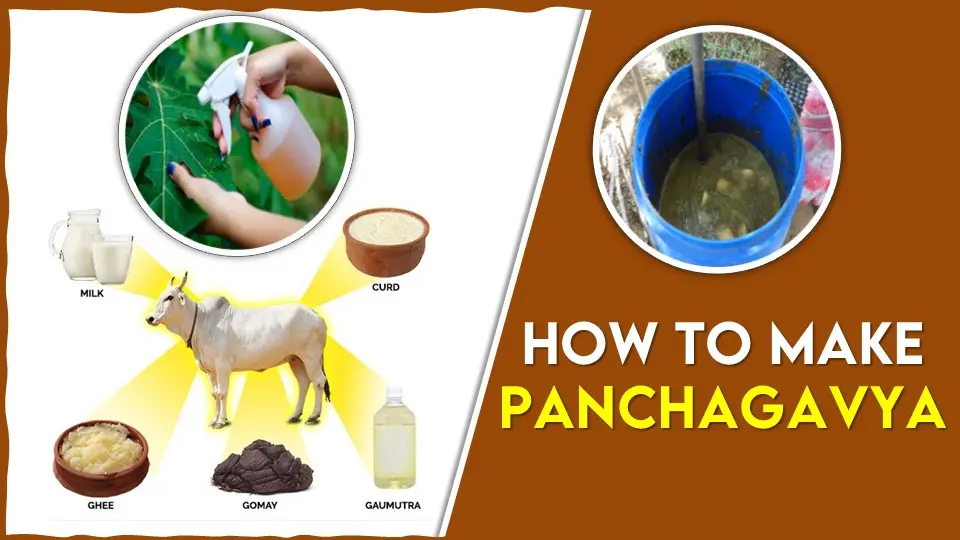Hello, my dear nature lovers!! Are you interested in Organic farming? Then here I am going to share a few things about Panchagavya and How To Make Panchagavya, along with its benefits and its role in providing a sustainable environment.
What is Panchagavya?
Panchagavya, an organic product has the potential to play the role of promoting growth and providing immunity in plant systems. Panchagavya is derived from the Sanskrit word, which means five cow derivatives. Panchagavya is a traditional Indian organic fertilizer prepared from the five derivatives of cow. They are Cow milk, Cow urine, Cow dung, Curd and Ghee. These five are the major constituents of this mixture. It’s based on ancient practices and is rich in the holistic principles of Ayurveda.
Along with these ingredients Tender coconut, Banana, and Jaggery are also added to prepare this mixture. This Panchagavya is a fermented product of all these products and mixed with water.
HOW TO MAKE PANCHAGAVYA
Now we are going to learn how to make the Panchagavya. We are going to make the Panchagavya as per TNAU recommendations.
INGREDIENTS:
- Cow dung
- Cow ghee
- Cow Urine
- Water
- Cow milk
- Cow curd
- Tender coconut water
- Jaggery
- Well-ripened banana
STEPS TO MAKE PANCHAGAVYA :
I have mentioned the steps on how to make Panchagavya
- Take 7kg of cow dung and 1 litre of Cow ghee and mix them thoroughly then keep it for 3 days.
- After 3 days, mix 10 liters of cow urine and 10 liters of water and keep it for 15 days with regular mixing both in the morning and evening hours.
- After 15 days mix 3 liters of cow milk, 2 litres of curd, along with 3 litres of tender coconut water, 3kg of Jaggery, and 12 well-ripened bananas.
- Then the panchagavya will be ready after 30 days
All the above items can be added to a wide-mouthed mud pot, concrete tank or plastic can as per the above order. The container should be kept open under shade. The content is to be stirred twice a day both in the morning and evening. The Panchagavya stock solution will be ready after 30 days. Now we can use the Panchagavya by diluting them in the required amount of water. It can be stored for a year.
NOTE:
- Care should be taken to not mix buffalo products.
- The products of Desi Cow breeds have a higher potency than exotic breeds.
- It should be kept in the shade and covered with a wire mesh plastic mosquito net. It helps us to prevent houseflies from laying eggs and the formation of maggots in the solution.

HOW TO APPLY PANCHAGAVYA TO PLANTS
Generally for all the crops 3 liters of Stock solution is mixed with 10 litres of water and applied to plants as foliar spray.
1- Spray system
From the investigations, we found that 3 % solution i.e. 3 liters of Panchagavya for every 100 liters of water is ideal for all crops. The power sprayers of 10 liters capacity may need 300 ml/tank. When we sprayed with a power sprayer, sediments were filtered, since it has a small pore size and when we sprayed with hand-operated sprayers, the nozzle with a higher pore size had to be used.
2- Flow system
The solution of Panchagavya can be mixed with irrigation water at 50 liters per hectare either through drip irrigation or a flow irrigation system. The sediments should be removed clearly.
3- Seed/seedling treatment
For seed treatment or seedling treatment, we need to prepare 3% of the Panchagayva solution from the already prepared stock solution. Soaking for 20 minutes is sufficient. Rhizomes of Turmeric, Ginger, and sets of Sugarcane can be soaked for 30 minutes before planting.
4- Seed storage
We used to dip the seeds in 3% of Panchagavya solution before drying and storing them.
Also Read:
EFFECT OF PANCHAGAVYA ON PLANTS
1- Leaf
- When we sprayed with Panchagavya, it invariably produced bigger leaves and developed a denser canopy.
- In plants the photosynthetic system is activated for enhanced biological efficiency, enabling the synthesis of maximum metabolites and photosynthates.
2- Stem
- In trees, the trunk produces side shoots, which are sturdy and capable of carrying maximum fruits to maturity.
- The branching is comparatively higher than normally grown plants
3- Roots
- The rooting in plants is profuse and dense.
- It helps the roots to spread and grow into deeper layers.
- It helps roots for maximum intake of nutrients and water.
4- Yield
- when the land is converted to organic farming from inorganic systems of culture, There will be yield loss under normal circumstances. During that time the Panchagavya helps to restore the yield level of all crops when the land is converted from an inorganic cultural system to an organic culture from the very first year.
- The harvest is made earlier by 15 days for all the crops.
- It enhances the shelf life of vegetables, fruits, and grains.
- It also improves the taste.
- It helps in reducing or replacing costly chemical inputs.
- Panchagavya ensures higher profit and liberates the organic farmers from the loan.
5- Drought Hardiness
- The panchagavya forms a thin oily film on the leaves and stems, thus reducing the evaporation of water.
- It helps to improve deep and extensive roots developed by the plants allow to withstand long dry periods.
- It contributes to reducing the irrigation water requirement by 30% and ensuring drought hardiness.
BENEFICIAL EFFECTS OF PANCHAGAVYA ON CROPS
Here we have discussed some benefits of panchagavya and its effects on plants.
| Crops | EFFECTS |
| Mango | It induces dense flowering with more hermaphrodite flowersIt induces the continues to fruit regularly. Alternate bearing is removedIt enhances keeping quality of the fruit.The shelf life is extended upto by 12 days at room temperatureIt provides extraordinary flavor and aroma |
| Acid lime | It ensures continuous and year around floweringThe fruits are plumpy and juicyIt provides a strong aromaThe shelf life is extended up to 10 days |
| Guava | It provides a more soluble sugar and acid ratioIt provides a shelf life of up to 7-10 days |
| Banana | During flowering, the Panchagavya solution is tied up in the bunched end to remove the male bud from the bunch.It ensures uniform ripening in banana bunchIt provides earlier harvesting The size of the banana is uniform from top to bottom of the bunch |
| Turmeric | It improves yield by 22%It enriches the curcumin contentIt provides extra long fingers. It helps the survival of dragonflies, spiders, etc which in turn reduces pest and disease load. |
| Jasmine | It provides more fragrance and aroma in flowersIt provides continuous flowering throughout the yearIt reduces the incidence of budworms and other pests |
| Vegetable crops | It enhances the yield by 18% in vegetable cropsIn cucumber-like vegetables, the yield is doubledIt extended the shelf lifeIt provides a strong flavor to the vegetablesIn vegetables like brinjal, tomato, etc. it provides a shiny appearance and appealing skin |
OTHER BENEFITS OF PANCHAGAVYA
Soil Fertility:
The cow dung and cow urine contain beneficial microbes that provide organic content to the soil. The products such as Cow milk, curd, and ghee contain soil nutrient bacteria such as Lactobacillus ssp. Which provides essential nutrients to the soil. Hence Panchagavya enriches soil fertility.
Skincare:
We can incorporate Panchagavya into our skincare routine. The milk is used to improve our skin tone by retaining the moisture content of our skim. The anti-bacterial effects of panchagavya remove harmful bacteria from our skin.
Home Cleaning:
The anti-bacterial properties present in the ingredients of Panchagavya help to kill harmful microbes. The cow urine is mixed with turmeric and used to clean our home floor.
Spiritual and Ritual Practices:
Panchagavya serves as a symbol of purity and positive energy. So, It’s often used in spiritual and ritual practices. The products of Panchagavya play an important role in divine rituals. It is considered holy material associated with Goddess Lakshmi. A cow is considered a sacred animal “Gomatha”.
Also Read:
CONCLUSION :
Adopting natural practices leads us to be healthy and happy for a long time. Nature is the best elixir of our life. In this world of trends, we are moving towards the path of habits that are not safe for our health. Panchagavya, our traditional organic input helps us to recover ourselves from the unhealthy evil path. It’s an eco-friendly product obtained naturally from cows, which helps us to lead a sustainable environment. It not only has its role in agriculture. It also has its unique role in various fields and helps us to save both ourselves as well as our environment. In this article we have discussed Panchagavya, How to make Panchagavya and its benefits in both Agriculture as well as environment.
Latest Post
- Top 10 Agricultural Drone Companies in India
- December Issue 2025- Times of Agriculture Magazine
- November Issue 2025- Times of Agriculture Magazine
- Punjab & Sind Bank Introduces Special Program to Support Food and Agro-Processing Sector
- Beyond Classrooms and Gardens: How a Professor Turned His Passion into Purpose
- October Issue 2025- Times of Agriculture Magazine
- Top 10 Pesticide Companies in the World
- September Issue 2025- Times of Agriculture Magazine
- Top 15 Fertilizer Companies in the World











